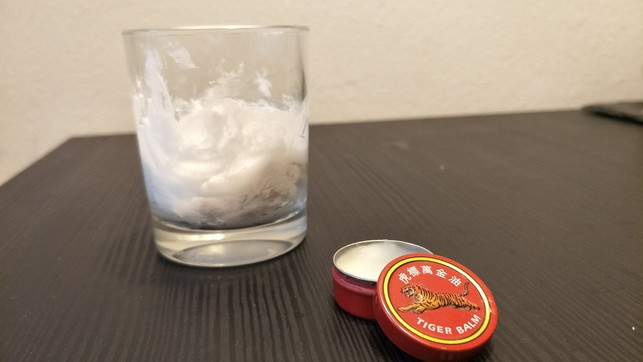
Tiger Balm is not only suitable for colds to clear your nose. We show you how you can make tiger balm yourself and how to use it correctly.
Tiger Balm comes from China and is available as a white or red ointment. Tiger Balm is actually a brand name, but there are many products with similar ingredients. The balm is considered a small miracle cure for colds and joint problems and is very effective: an amount the size of two grains of rice is said to be enough to help against numerous ailments.
Here you will find an overview of the effects, application and production of Tiger Balm.
Using Tiger Balm: What does Tiger Balm help against?

(Photo: CC0 / Pixabay / Peggy_Marco)
Tiger Balm is said to have numerous effects. Here we have listed the most important ones for you:
-
Cold: Tiger Balm works similarly to cold balm: it promotes blood circulation and provides warmth. You can rub it on your chest and back. The menthol it contains has a cooling effect: As scientists have discovered, inhaling air containing menthol reduces the unpleasant feeling of blocked breathing. Studies also show that the menthol contained in Tiger Balm can improve breathing problems.
-
Migraines and headaches: If you have a headache, you can rub some Tiger Balm on your temple. If you have a migraine, a little cream on your neck will help. A study comparing paracetamol with Tiger Balm and a placebo for headaches shows that Tiger Balm helps almost as well as the drug and noticeably better than the placebo.
-
Muscle and joint pain: Tiger Balm can also relieve pain if you have a strain or sprain. The balm is also a good first aid measure for muscle pain. Under no circumstances should you use it on open wounds. Camphor, found not only in Tiger Balm but also in other products such as Vick VapoRub and Bengay, has been shown in studies to provide pain relief.
-
Heavy sweating: If you sweat often, you can apply Tiger Balm under your armpits. Even the smallest amounts of the balm should eliminate the smell of sweat and ensure that you sweat less, at least temporarily. Tiger Balm’s strong scent can also help temporarily mask the smell.
By the way, you can also use Tiger Balm to repel insects: While people find the smell of the essential oils pleasant, it primarily repels mosquitoes. Just a fingertip of tiger balm can be enough.
Possible side effects of Tiger Balm
A meta-study from 2020 found that Tiger Balm can cause skin irritation and only has a demonstrable effect on acute pressure headaches. Attention: If symptoms persist, you should seek medical advice.
The ingredient camphor also poses some risks and should never be swallowed: in small children, swallowed camphor can be fatal, even in small doses.
Red or white: the effect of Tiger Balm

(Photo: Sven Christian Schulz / Utopia)
White Tiger Balm smells of peppermint and eucalyptus – red Tiger Balm, on the other hand, smells of cinnamon and cloves. The effect of the two ointments differs only slightly:
-
White Tiger Balm probably helps especially with colds. The peppermint oil it contains clears the respiratory tract by loosening mucus from the bronchi and clearing the nose. The clove oil and camphor have a disinfecting effect and relieve pain. Camphor also relaxes the bronchi. Cajeput oil ensures good blood circulation.
-
Red Tiger Balm is said to help with muscle and joint pain. The active ingredients contained are largely identical, only the composition is slightly different. Red Tiger Balm contains more cooling menthol, which can help with joint pain. The ointment gets its red color from cinnamon oil.
Please note that Tiger Balm is said to have these effects and there is concrete evidence for a few points. It’s best to try it out for yourself and find out what works.
Make your own Tiger Balm

(Photo: Sven Christian Schulz / Utopia)
Tiger Balm is available in drugstores and larger supermarkets, but you can also make a similar balm yourself. For this you need the following ingredients:
- 15 grams of coconut oil (available at Avocadostore),
- 4 grams beeswax or carnauba wax
- 15 grams of sunflower or sesame oil,
- 8 grams Cajeput essential oil (available on Amazon),
- 2 grams clove essential oil (available on Amazon),
- 5 grams of peppermint essential oil (available on Amazon).
Directions:
- First melt coconut oil, beeswax and sunflower oil in a water bath. As soon as all the ingredients are liquid, you can remove them from the heat.
- Then weigh out the essential oils and add them.
- Now you have to stir well until the oils have completely mixed with the wax.
- Then fill the Tiger Balm into a small container. You should boil this beforehand to protect your tiger balm from contamination and to make it last longer.
You can find out how to do this here: Sterilizing jars: The best methods with step-by-step instructions
Read more at Techzle\.com:
- Prevent colds: How to stay healthy
- Rubbing alcohol: Use and effect for muscle and joint problems
- Cold tea: These varieties help against coughs, colds and sore throats
Edited by Lina Brammertz
** marked with ** or orange underlined Links to sources of supply are partly partner links: If you buy here, you are actively supporting Techzle\.com, because we then receive a small part of the sales proceeds. More info.